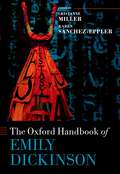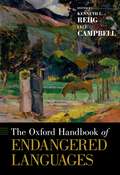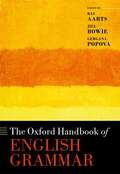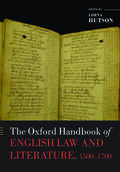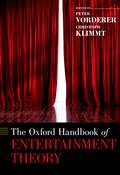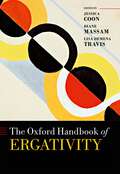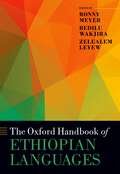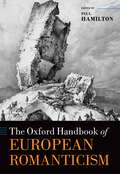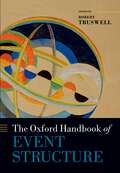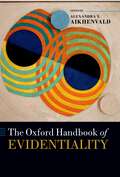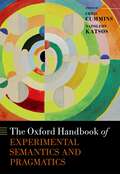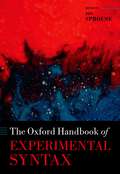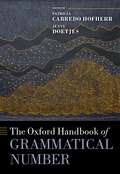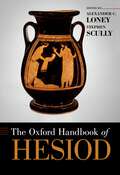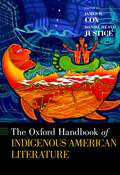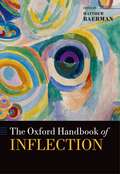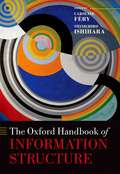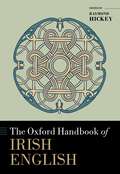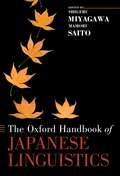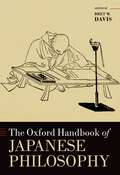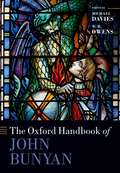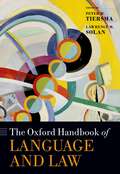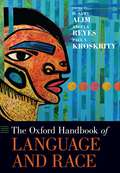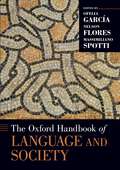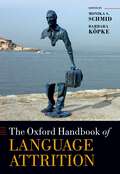- Table View
- List View
The Oxford Handbook of Emily Dickinson (Oxford Handbooks)
The Oxford Handbook of Emily Dickinson is designed to engage, inform, interest, and delight students and scholars of Emily Dickinson, of nineteenth-century US literature and cultural studies, of American poetry, and of the lyric. It also establishes potential agendas for future work in the field of Dickinson studies. This is the first collection on Dickinson to foreground the material and social culture of her time while opening new windows to interpretive possibility in ours. The volume strives to balance Dickinson's own center of gravity in the material culture and historical context of nineteenth-century Amherst with the significance of important critical conversations of our present, thus understanding her poetry with the broadest "Latitude of Home"—as she puts it in her poem "Forever-is composed of Nows." Debates about the lyric, about Dickinson's manuscripts and practices of composition, about the viability of translation across language, media, and culture, and about the politics of class, gender, place, and race circulate through this volume. These debates matter to our moment but also to our understanding of hers. Although rooted in the evolving history of Dickinson criticism, the chapters foreground truly new original research and a wide range of innovative critical methodologies, including artistic responses to her poetry by musicians, visual artists, and other poets. The suppleness and daring of Dickinson's thought and uses of language remain open to new possibilities and meanings, even while they are grounded in contexts from over 150 years ago, and this collection expresses and celebrates the breadth of her accomplishments and relevance.
The Oxford Handbook of Endangered Languages (Oxford Handbooks)
The endangered languages crisis is widely acknowledged among scholars who deal with languages and indigenous peoples as one of the most pressing problems facing humanity, posing moral, practical, and scientific issues of enormous proportions. Simply put, no area of the world is immune from language endangerment. The Oxford Handbook of Endangered Languages, in 39 chapters, provides a comprehensive overview of the efforts that are being undertaken to deal with this crisis. A comprehensive reference reflecting the breadth of the field, the Handbook presents in detail both the range of thinking about language endangerment and the variety of responses to it, and broadens understanding of language endangerment, language documentation, and language revitalization, encouraging further research. The Handbook is organized into five parts. Part 1, Endangered Languages, addresses the fundamental issues that are essential to understanding the nature of the endangered languages crisis. Part 2, Language Documentation, provides an overview of the issues and activities of concern to linguists and others in their efforts to record and document endangered languages. Part 3, Language Revitalization, includes approaches, practices, and strategies for revitalizing endangered and sleeping ("dormant") languages. Part 4, Endangered Languages and Biocultural Diversity, extends the discussion of language endangerment beyond its conventional boundaries to consider the interrelationship of language, culture, and environment, and the common forces that now threaten the sustainability of their diversity. Part 5, Looking to the Future, addresses a variety of topics that are certain to be of consequence in future efforts to document and revitalize endangered languages.
The Oxford Handbook of English Grammar (Oxford Handbooks)
This handbook provides an authoritative, critical survey of current research and knowledge in the grammar of the English language. Following an introduction from the editors, the volume's expert contributors explore a range of core topics in English grammar, beginning with issues in grammar writing and methodology. Chapters in part II then examine the various theoretical approaches to grammar, such as cognitive, constructional, and generative approaches, followed by the chapters in part III, which comprehensively cover the different subdomains of grammar, including compounds, phrase structure, clause types, tense and aspect, and information structure. Part IV offers coverage of the relationship between grammar and other fields - lexis, phonology, meaning, and discourse - while the concluding part of the book investigates grammatical change over time, regional variation, and genre and literary variation. The handbook's wide-ranging coverage will appeal to researchers and students of English language and linguistics from undergraduate level upwards.
The Oxford Handbook of English Law and Literature, 1500-1700 (Oxford Handbooks)
This Handbook triangulates the disciplines of history, legal history, and literature to produce a new, interdisciplinary framework for the study of early modern England. Scholars of early modern English literature and history have increasingly found that an understanding of how people in the past thought about and used the law is key to understanding early modern familial and social relations as well as important aspects of the political revolution and the emergence of capitalism. Judicial or forensic rhetoric has been shown to foster new habits of literary composition (poetry and drama) and new processes of fact-finding and evidence evaluation. In addition, the post-Reformation jurisdictional dominance of the common law produced new ways of drawing the boundaries between private conscience and public accountability. Accordingly, historians, critics, and legal historians come together in this Handbook to develop accounts of the past that are attentive to the legally purposeful or fictional shaping of events in the historical archive. They also contribute to a transformation of our understanding of the place of forensic modes of inquiry in the creation of imaginative fiction and drama. Chapters in the Handbook approach, from a diversity of perspectives, topics including forensic rhetoric, humanist and legal education, Inns of Court revels, drama, poetry, emblem books, marriage and divorce, witchcraft, contract, property, imagination, oaths, evidence, community, local government, legal reform, libel, censorship, authorship, torture, slavery, liberty, due process, the nation state, colonialism, and empire.
The Oxford Handbook of Entertainment Theory (Oxford Handbooks)
The proliferation of new digital technologies has given rise to an entirely changed media landscape and revolutionized how we seek entertainment. Older entertainment media like novels, radio, and film have been joined by a host of digital media that smartphones allow us to carry almost anywhere and at all times, from video games and social media to video on demand services. This unprecedented ubiquity of entertainment media calls for new and more sophisticated theories that help us understand the fascination that different entertainment media exert on us and how they change the human experience. The Oxford Handbook of Entertainment Theory surveys and furthers the most influential psychology-driven research on media entertainment to illuminate how people are drawn into media experiences. The 41 chapters in this Handbook not only offer fresh perspectives on established theories but also introduce emerging models and highlight the importance of considering the diverse backgrounds of media users when conducting research. They also cover the motivations and reactions of media users in relationship to different types of media, the trend towards interactive media such as video games and virtual reality, and particularly popular media contents like sexuality, violence, sports, and the news. As the most comprehensive overview of psychology-based research on media entertainment available, this Handbook is an invaluable resource for seasoned researchers and those beginning to learn about the field alike.
The Oxford Handbook of Ergativity (Oxford Handbooks)
This volume offers theoretical and descriptive perspectives on the issues pertaining to ergativity, a grammatical patterning whereby direct objects are in some way treated like intransitive subjects, to the exclusion of transitive subjects. This pattern differs markedly from nominative/accusative marking whereby transitive and intransitive subjects are treated as one grammatical class, to the exclusion of direct objects. While ergativity is sometimes referred to as a typological characteristic of languages, research on the phenomenon has shown that languages do not fall clearly into one category or the other and that ergative characteristics are not consistent across languages. Chapters in this volume look at approaches to ergativity within generative, typological, and functional paradigms, as well as approaches to the core morphosyntactic building blocks of an ergative construction; related constructions such as the anti-passive; related properties such as split ergativity and word order; and extensions and permutations of ergativity, including nominalizations and voice systems. The volume also includes results from experimental investigations of ergativity, a relatively new area of research. A wide variety of languages are represented, both in the theoretical chapters and in the 16 case studies that are more descriptive in nature, attesting to both the pervasiveness and diversity of ergative patterns.
The Oxford Handbook of Ethiopian Languages (Oxford Handbooks)
This handbook provides a comprehensive account of the languages spoken in Ethiopia, exploring both their structures and features and their function and use in society. The first part of the volume provides background and general information relating to Ethiopian languages, including their demographic distribution and classification, language policy, scripts and writing, and language endangerment. Subsequent parts are dedicated to the four major language families in Ethiopia - Cushitic, Ethiosemitic, Nilo-Saharan, and Omotic - and contain studies of individual languages, with an initial introductory overview chapter in each part. Both major and less-documented languages are included, ranging from Amharic and Oromo to Zay, Gawwada, and Yemsa. The final part explores languages that are outside of those four families, namely Ethiopian Sign Language, Ethiopian English, and Arabic. With its international team of senior researchers and junior scholars, The Oxford Handbook of Ethiopian Languages will appeal to anyone interested in the languages of the region and in African linguistics more broadly.
The Oxford Handbook of European Romanticism (Oxford Handbooks)
TThe Oxford Handbook to European Romanticism brings together leading scholars in the field to examine the intellectual, literary, philosophical, and political elements of European Romanticism. The book focuses on the cultural history of the period extending from the French Revolution to the uprisings of 1848. It begins with a series of chapters examining key texts written by major writers in languages including: French; German; Italian; Spanish; Russian; Hungarian; Greek; and Polish amongst others. A second section then explores the naturally inter-disciplinary quality of Romanticism, exemplified by the different discourses with which writers of the time set up an internal, comparative dynamic. These chapters highlight the sense a discourse gives of being written knowledgeably against other pretenders to completeness or comprehensiveness of self-understanding of the time. Discourses typically advance their own claims to resume European culture, collaborating with and at the same time trying to assimilate each other in the process. The main examples featured here are: history; geography; drama; theology; language; philosophy; political theory; the sciences; and the media. Each chapter offers an original and individual interpretation of an inherently comparative world of individual writers and the discursive idioms to which they are historically subject. Together the forty-one chapters provide a comprehensive and provocative overview of European Romanticism.
The Oxford Handbook of Event Structure (Oxford Handbooks)
This handbook deals with research into the nature of events, and how we use language to describe events. The study of event structure over the past 60 years has been one of the most successful areas of lexical semantics, uniting insights from morphology and syntax, lexical and compositional semantics, cognitive science, and artificial intelligence to develop insightful theories of events and event descriptions. This volume provides accessible introductions to major topics and ongoing debates in event structure research, exploring what events are, how we perceive them, how we reason with them, and the role they play in the organization of grammar and discourse. The chapters are divided into four parts: the first covers metaphysical issues related to events; the second is concerned with the relationship between event structure and grammar; the third is a series of crosslinguistic case studies; and the fourth deals with links to cognitive science and artificial intelligence more broadly. The book is strongly interdisciplinary in nature, with insights from linguistics, philosophy, psychology, cognitive science, and computer science, and will appeal to a wide range of researchers and students from advanced undergraduate level upwards.
The Oxford Handbook of Evidentiality (Oxford Handbooks)
This volume offers a thorough, systematic, and crosslinguistic account of evidentiality, the linguistic encoding of the source of information on which a statement is based. In some languages, the speaker always has to specify this source - for example whether they saw the event, heard it, inferred it based on visual evidence or common sense, or was told about it by someone else. While not all languages have obligatory marking of this type, every language has ways of referring to information source and associated epistemological meanings. The continuum of epistemological expressions covers a range of devices from the lexical means in familiar European languages and in many languages of Aboriginal Australia to the highly grammaticalized systems in Amazonia or North America. In this handbook, experts from a variety of fields explore topics such as the relationship between evidentials and epistemic modality, contact-induced changes in evidential systems, the acquisition of evidentials, and formal semantic theories of evidentiality. The book also contains detailed case studies of evidentiality in language families across the world, including Algonquian, Korean, Nakh-Dagestanian, Nambikwara, Turkic, Uralic, and Uto-Aztecan.
The Oxford Handbook of Experimental Semantics and Pragmatics (Oxford Handbooks)
This handbook is the first to explore the growing field of experimental semantics and pragmatics. In the past 20 years, experimental data has become a major source of evidence for building theories of language meaning and use, encompassing a wide range of topics and methods. Following an introduction from the editors, the chapters in this volume offer an up-to-date account of research in the field spanning 31 different topics, including scalar implicatures, presuppositions, counterfactuals, quantification, metaphor, prosody, and politeness, as well as exploring how and why a particular experimental method is suitable for addressing a given theoretical debate. The volume's forward-looking approach also seeks to actively identify questions and methods that could be fruitfully combined in future experimental research. Written in a clear and accessible style, this handbook will appeal to students and scholars from advanced undergraduate level upwards in a range of fields, including semantics and pragmatics, philosophy of language, psycholinguistics, computational linguistics, cognitive science, and neuroscience.
The Oxford Handbook of Experimental Syntax (Oxford Handbooks)
This volume showcases the contributions that formal experimental methods can make to syntactic research in the 21st century. Syntactic theory is both a domain of study in its own right, and one component of an integrated theory of the cognitive neuroscience of language. It provides a theory of the mediation between sound and meaning, a theory of the representations constructed during sentence processing, and a theory of the end-state for language acquisition. Given the highly interactive nature of the theory of syntax, this volume defines "experimental syntax" in the broadest possible terms, exploring both formal experimental methods that have been part of the domain of syntax since its inception (i.e., acceptability judgment methods) and formal experimental methods that have arisen through the interaction of syntactic theory with the domains of acquisition, psycholinguistics, and neurolinguistics. The Oxford Handbook of Experimental Syntax brings these methods together into a single experimental syntax volume for the first time, providing high-level reviews of major experimental work, offering guidance for researchers looking to incorporate these diverse methods into their own work, and inspiring new research that will push the boundaries of the theory of syntax. It will appeal to students and scholars from the advanced undergraduate level upwards in a range of fields including syntax, acquisition, psycholinguistics, neurolinguistics, and computational linguistics.
The Oxford Handbook of Grammatical Number (Oxford Handbooks)
This volume offers detailed accounts of current research in grammatical number in language. Following a detailed introduction, the chapters in the first three parts of the book explore the multiple research questions in the field and the complex problems surrounding the analysis of grammatical number: Part I presents the background and foundational notions, Part II the morphological, semantic, and syntactic aspects, and Part III the different means of expressing plurality in the event domain. The final part offers fifteen case studies that include in-depth discussion of grammatical number phenomena in a range of typologically diverse languages, written by - or in collaboration with - native speakers linguists or based on extensive fieldwork. The volume draws on work from a range of subdisciplines - including morphology, syntax, semantics, and psycholinguistics - and will be a valuable resource for students and scholars in all areas of theoretical, descriptive, and experimental linguistics.
The Oxford Handbook of Hesiod (Oxford Handbooks)
This volume brings together 29 junior and senior scholars to discuss aspects of Hesiod's poetry and its milieu and to explore questions of reception over two and half millennia from shortly after the poems' conception to Twitter hashtags. Rather than an exhaustive study of Hesiodic themes, the Handbook is conceived as a guide through terrain, some familiar, other less charted, examining both Hesiodic craft and later engagements with Hesiod's stories of the gods and moralizing proscriptions of just human behavior. The volume opens with the "Hesiodic Question," to address questions of authorship, historicity, and the nature of composition of Hesiod's two major poems, the Theogony and Works and Days. Subsequent chapters on the archaeology and economic history of archaic Boiotia, Indo-European poetics, and Hesiodic style offer a critical picture of the sorts of questions that have been asked rather than an attempt to resolve debate. Other chapters discuss Hesiod's particular rendering of the supernatural and the performative nature of the Works and Days, as well as competing diachronic and synchronic temporalities and varying portrayals of female in the two poems. The rich story of reception ranges from Solon to comic books. These chapters continue to explore the nature of Hesiod's poetics, as different writers through time single out new aspects of his art less evident to earlier readers. Long before the advent of Christianity, classical writers leveled their criticism at Hesiod's version of polytheism. The relative importance of Hesiod's two major poems across time also tells us a tale of the age receiving the poems. In the past two centuries, artists and writers have come to embrace the Hesiodic stories for themselves for the insight they offer of the human condition but even as old allegory looks quaint to modern eyes new forms of allegory take form.
The Oxford Handbook of Indigenous American Literature (Oxford Handbooks)
Over the course of the last twenty years, Native American and Indigenous American literary studies has experienced a dramatic shift from a critical focus on identity and authenticity to the intellectual, cultural, political, historical, and tribal nation contexts from which these Indigenous literatures emerge. The Oxford Handbook of Indigenous American Literature reflects on these changes and provides a complete overview of the current state of the field. The Handbook's forty-three essays, organized into four sections, cover oral traditions, poetry, drama, non-fiction, fiction, and other forms of Indigenous American writing from the seventeenth through the twenty-first century. Part I attends to literary histories across a range of communities, providing, for example, analyses of Inuit, Chicana/o, Anishinaabe, and Métis literary practices. Part II draws on earlier disciplinary and historical contexts to focus on specific genres, as authors discuss Indigenous non-fiction, emergent trans-Indigenous autobiography, Mexicanoh and Spanish poetry, Native drama in the U.S. and Canada, and even a new Indigenous children's literature canon. The third section delves into contemporary modes of critical inquiry to expound on politics of place, comparative Indigenism, trans-Indigenism, Native rhetoric, and the power of Indigenous writing to communities of readers. A final section thoroughly explores the geographical breadth and expanded definition of Indigenous American through detailed accounts of literature from Indian Territory, the Red Atlantic, the far North, Yucatán, Amerika Samoa, and Francophone Quebec. Together, the volume is the most comprehensive and expansive critical handbook of Indigenous American literatures published to date. It is the first to fully take into account the last twenty years of recovery and scholarship, and the first to most significantly address the diverse range of texts, secondary archives, writing traditions, literary histories, geographic and political contexts, and critical discourses in the field.
The Oxford Handbook of Inflection (Oxford Handbooks)
This is the latest addition to a group of handbooks covering the field of morphology, alongside The Oxford Handbook of Case (2008), The Oxford Handbook of Compounding (2009), and The Oxford Handbook of Derivational Morphology (2014). It provides a comprehensive state-of-the-art overview of work on inflection - the expression of grammatical information through changes in word forms. The volume's 24 chapters are written by experts in the field from a variety of theoretical backgrounds, with examples drawn from a wide range of languages. The first part of the handbook covers the fundamental building blocks of inflectional form and content: morphemes, features, and means of exponence. Part 2 focuses on what is arguably the most characteristic property of inflectional systems, paradigmatic structure, and the non-trivial nature of the mapping between function and form. The third part deals with change and variation over time, and the fourth part covers computational issues from a theoretical and practical standpoint. Part 5 addresses psycholinguistic questions relating to language acquisition and neurocognitive disorders. The final part is devoted to sketches of individual inflectional systems, illustrating a range of typological possibilities across a genetically diverse set of languages from Africa, Asia and the Pacific, Australia, Europe, and South America.
The Oxford Handbook of Information Structure (Oxford Handbooks)
This book provides linguists with a clear, critical, and comprehensive overview of theoretical and experimental work on information structure. Leading researchers survey the main theories of information structure in syntax, phonology, and semantics as well as perspectives from psycholinguistics and other relevant fields. Following the editors' introduction the book is divided into four parts. The first, on theories of and theoretical perspectives on information structure, includes chapters on focus, topic, and givenness. Part 2 covers a range of current issues in the field, including quantification, dislocation, and intonation, while Part 3 is concerned with experimental approaches to information structure, including language processing and acquisition. The final part contains a series of linguistic case studies drawn from a wide variety of the world's language families. This volume will be the standard guide to current work in information structure and a major point of departure for future research.
The Oxford Handbook of Irish English (Oxford Handbooks)
This volume offers a comprehensive overview of the range of varieties of English spoken on the island of Ireland, featuring information on their historical background, structural features, and sociolinguistic considerations. The first part of the volume explores English and Irish in their historical framework as well as current issues of contact and bilingualism. Chapters in Part II and Part III investigate the structures and use of Irish English today, from pronunciation and grammar to discourse-pragmatic markers and politeness strategies, alongside studies of specific varieties such as Urban English in Northern Ireland and the Irish English spoken in Dublin, Galway, and Cork. Part IV focuses on the Irish diaspora, with chapters covering topics including Newfoundland Irish English and Irish influence on Australian English, while the final part looks at the wider context, such as the language of Irish Travellers and Irish Sign Language. The handbook also features a detailed glossary of key terms, and will be of interest to a wide range of readers interested in varieties of English, Irish studies, sociolinguistics, and social and cultural history.
Oxford Handbook of Japanese Linguistics (Oxford Handbooks)
Over the past twenty years or so, the work on Japanese within generative grammar has shifted from primarily using contemporary theory to describe Japanese to contributing directly to general theory, on top of producing extensive analyses of the language. The Oxford Handbook of Japanese Linguistics captures the excitement that comes from answering the question, "What can Japanese say about Universal Grammar?" Each of the eighteen chapters takes up a topic in syntax, morphology, acquisition, processing, phonology, or information structure, and, first of all, lays out the core data, followed by critical discussion of the various approaches found in the literature. Each chapter ends with a section on how the study of the particular phenomenon in Japanese contributes to our knowledge of general linguistic theory. This book will be useful to students and scholars of linguistics who are interested in the latest studies on one of the most extensively studied languages within generative grammar.
The Oxford Handbook of Japanese Philosophy (Oxford Handbooks)
Japanese philosophy is now a flourishing field with thriving societies, journals, and conferences dedicated to it around the world, made possible by an ever-increasing library of translations, books, and articles. The Oxford Handbook of Japanese Philosophy is a foundation-laying reference work that covers, in detail and depth, the entire span of this philosophical tradition, from ancient times to the present. It introduces and examines the most important topics, figures, schools, and texts from the history of philosophical thinking in premodern and modern Japan. Each chapter, written by a leading scholar in the field, clearly elucidates and critically engages with its topic in a manner that demonstrates its contemporary philosophical relevance. The Handbook opens with an extensive introductory chapter that addresses the multifaceted question, "What is Japanese Philosophy?" The first fourteen chapters cover the premodern history of Japanese philosophy, with sections dedicated to Shinto and the Synthetic Nature of Japanese Philosophical Thought, Philosophies of Japanese Buddhism, and Philosophies of Japanese Confucianism and Bushido. Next, seventeen chapters are devoted to Modern Japanese Philosophies. After a chapter on the initial encounter with and appropriation of Western philosophy in the late nineteenth-century, this large section is divided into one subsection on the most well-known group of twentieth-century Japanese philosophers, The Kyoto School, and a second subsection on the no less significant array of Other Modern Japanese Philosophies. Rounding out the volume is a section on Pervasive Topics in Japanese Philosophical Thought, which covers areas such as philosophy of language, philosophy of nature, ethics, and aesthetics, spanning a range of schools and time periods. This volume will be an invaluable resource specifically to students and scholars of Japanese philosophy, as well as more generally to those interested in Asian and comparative philosophy and East Asian studies.
The Oxford Handbook of John Bunyan (Oxford Handbooks)
The Oxford Handbook of John Bunyan is the most extensive volume of original essays ever published on the seventeenth-century Nonconformist preacher and writer, John Bunyan. Its thirty-eight chapters examine Bunyan's life and works, their religious and historical contexts, and the critical reception of his writings, in particular his allegorical narrative, The Pilgrim's Progress. Interdisciplinary and comprehensive, it provides unparalleled scope and expertise, ranging from literary theory to religious history and from theology to post-colonial criticism. The Handbook is structured in four sections. The first, 'Contexts', deals with the historical Bunyan in relation to various aspects of his life, background, and work as a Nonconformist: from basic facts of biography to the nature of his church at Bedford, his theology, and the religious and political cultures of seventeenth-century Dissent. Part 2 considers Bunyan's literary output: from his earliest printed tracts to his posthumously published works. Offering discrete chapters on Bunyan's major works—Grace Abounding to the Chief of Sinners (1666), The Pilgrim's Progress, Parts I and II (1678; 1684); The Life and Death of Mr. Badman (1680), and The Holy War (1682)—this section nevertheless covers Bunyan's oeuvre in its entirety: controversial and pastoral, narrative and poetic. Section 3, 'Directions in Criticism', engages with Bunyan in literary critical terms, focusing on his employment of form and language and on theoretical approaches to his writings: from psychoanalytic to post-secular criticism. Section 4, 'Journeys', tackles some of the ways in which Bunyan's works, and especially The Pilgrim's Progress, have travelled throughout the world since the late seventeenth century, assessing Bunyan's place within key literary periods and their distinctive developments: from the eighteenth-century novel to the writing of 'empire.'
The Oxford Handbook of Language and Law (Oxford Handbooks)
This book provides a state-of-the-art account of past and current research in the interface between linguistics and law. It outlines the range of legal areas in which linguistics plays an increasing role and describes the tools and approaches used by linguists and lawyers in this vibrant new field. Through a combination of overview chapters, case studies, and theoretical descriptions, the volume addresses areas such as the history and structure of legal language, its meaning and interpretation, multilingualism and language rights, courtroom discourse, forensic identification, intellectual property and linguistics, and legal translation and interpretation. Encyclopaedic in scope, the handbook includes chapters written by experts from every contentint who are familiar with linguistic issues that arise in diverse legal systems, including both civil and common law jurisdictions, mixed systems like that of China, and the emerging law of the European Union.
The Oxford Handbook of Language and Race (Oxford Handbooks)
Over the past two decades, the fields of linguistic anthropology and sociolinguistics have complicated traditional understandings of the relationship between language and identity. But while research traditions that explore the linguistic complexities of gender and sexuality have long been established, the study of race as a linguistic issue has only emerged recently. The Oxford Handbook of Language and Race positions issues of race as central to language-based scholarship. In twenty-one chapters divided into four sections-Foundations and Formations; Coloniality and Migration; Embodiment and Intersectionality; and Racism and Representations-authors at the forefront of this rapidly expanding field present state-of-the-art research and establish future directions of research. Covering a range of sites from around the world, the handbook offers theoretical, reflexive takes on language and race, the larger histories and systems that influence these concepts, the bodies that enact and experience them, and the expressions and outcomes that emerge as a result. As the study of language and race continues to take on a growing importance across anthropology, communication studies, cultural studies, education, linguistics, literature, psychology, ethnic studies, sociology, and the academy as a whole, this volume represents a timely, much-needed effort to focus these fields on both the central role that language plays in racialization and on the enduring relevance of race and racism.
The Oxford Handbook of Language and Society (Oxford Handbooks)
This Oxford Handbook challenges basic concepts that have informed the study of sociolinguistics since its inception in the 1960s. In 27 chapters, the book challenges the modernist positivist perspective of the field that has treated languages and speech communities as bounded and the idealized native speaker as the ultimate authority. Instead, it offers a critical poststructuralist perspective that examines the socio-historical context that led to the emergence of dominant sociolinguistic concepts and develops new theoretical and methodological tools that challenge these dominant concepts. The contributors to this volume take this critical poststructuralist perspective as a starting point for engaging in explorations of a range of sociolinguistic topics including language variation, language ideologies, bi/multilingualism, language policy, linguistic landscapes and multimodality. Each of the contributors provides a critical overview of the limits of modernist positivist perspectives on their topic and offer ways of theorizing and researching their topic in ways that are aligned with a critical poststructuralist perspective. The book also provides a global perspective on these issues with contributors focused on North and South America, Europe, Australia, and Africa. Together, the interdisciplinary and global contributions reveal the limits of conventional approaches to sociolinguistics and offer a glimpse into directions for the future of the field.
The Oxford Handbook of Language Attrition (Oxford Handbooks)
This volume is the first handbook dedicated to language attrition, the study of how a speaker's language may be affected by crosslinguistic interference and non-use. The effects of language attrition can be felt in all aspects of language knowledge, processing, and production, and can offer unique insights into the mind of bilingual language users. In this book, international experts in the field explore a comprehensive range of topics in language attrition, examining its theoretical implications, psycho- and neurolinguistic approaches, linguistic and extralinguistic factors, L2 attrition, and heritage languages. The chapters summarize current research and draw on insights from related fields such as child language development, language contact, language change, pathological developments, and second language acquisition.
